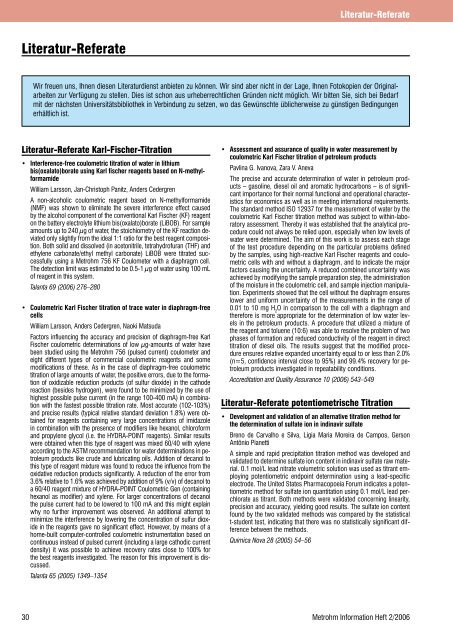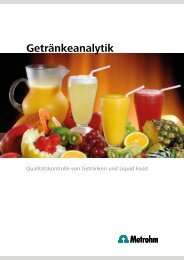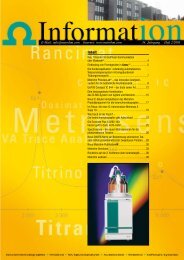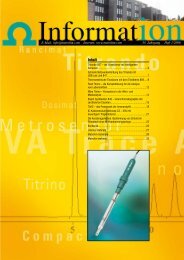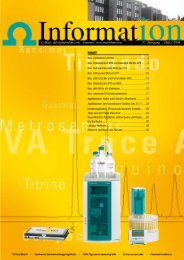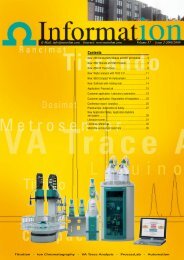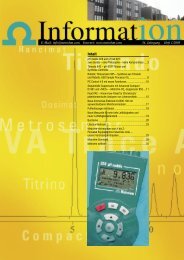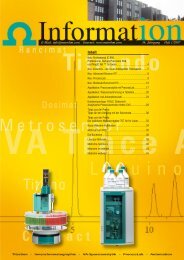Download (PDF) - Metrohm AG
Download (PDF) - Metrohm AG
Download (PDF) - Metrohm AG
Sie wollen auch ein ePaper? Erhöhen Sie die Reichweite Ihrer Titel.
YUMPU macht aus Druck-PDFs automatisch weboptimierte ePaper, die Google liebt.
Literatur-Referate<br />
Literatur-Referate<br />
Wir freuen uns, Ihnen diesen Literaturdienst anbieten zu können. Wir sind aber nicht in der Lage, Ihnen Fotokopien der Originalarbeiten<br />
zur Verfügung zu stellen. Dies ist schon aus urheberrechtlichen Gründen nicht möglich. Wir bitten Sie, sich bei Bedarf<br />
mit der nächsten Universitätsbibliothek in Verbindung zu setzen, wo das Gewünschte üblicherweise zu günstigen Bedingungen<br />
erhältlich ist.<br />
Literatur-Referate Karl-Fischer-Titration<br />
• Interference-free coulometric titration of water in lithium<br />
bis(oxalato)borate using Karl fischer reagents based on N-methylformamide<br />
William Larsson, Jan-Christoph Panitz, Anders Cedergren<br />
A non-alcoholic coulometric reagent based on N-methylformamide<br />
(NMF) was shown to eliminate the severe interference effect caused<br />
by the alcohol component of the conventional Karl Fischer (KF) reagent<br />
on the battery electrolyte lithium bis(oxalato)borate (LiBOB). For sample<br />
amounts up to 240 µg of water, the stoichiometry of the KF reaction deviated<br />
only slightly from the ideal 1:1 ratio for the best reagent composition.<br />
Both solid and dissolved (in acetonitrile, tetrahydrofuran (THF) and<br />
ethylene carbonate/ethyl methyl carbonate) LiBOB were titrated successfully<br />
using a <strong>Metrohm</strong> 756 KF Coulometer with a diaphragm cell.<br />
The detection limit was estimated to be 0.5-1 µg of water using 100 mL<br />
of reagent in this system.<br />
Talanta 69 (2006) 276–280<br />
• Coulometric Karl Fischer titration of trace water in diaphragm-free<br />
cells<br />
William Larsson, Anders Cedergren, Naoki Matsuda<br />
Factors influencing the accuracy and precision of diaphragm-free Karl<br />
Fischer coulometric determinations of low µg-amounts of water have<br />
been studied using the <strong>Metrohm</strong> 756 (pulsed current) coulometer and<br />
eight different types of commercial coulometric reagents and some<br />
modifications of these. As in the case of diaphragm-free coulometric<br />
titration of large amounts of water, the positive errors, due to the formation<br />
of oxidizable reduction products (of sulfur dioxide) in the cathode<br />
reaction (besides hydrogen), were found to be minimized by the use of<br />
highest possible pulse current (in the range 100-400 mA) in combination<br />
with the fastest possible titration rate. Most accurate (102-103%)<br />
and precise results (typical relative standard deviation 1.8%) were obtained<br />
for reagents containing very large concentrations of imidazole<br />
in combination with the presence of modifiers like hexanol, chloroform<br />
and propylene glycol (i.e. the HYDRA-POINT reagents). Similar results<br />
were obtained when this type of reagent was mixed 60/40 with xylene<br />
according to the ASTM recommendation for water determinations in petroleum<br />
products like crude and lubricating oils. Addition of decanol to<br />
this type of reagent mixture was found to reduce the influence from the<br />
oxidative reduction products significantly. A reduction of the error from<br />
3.6% relative to 1.6% was achieved by addition of 9% (v/v) of decanol to<br />
a 60/40 reagent mixture of HYDRA-POINT Coulometric Gen (containing<br />
hexanol as modifier) and xylene. For larger concentrations of decanol<br />
the pulse current had to be lowered to 100 mA and this might explain<br />
why no further improvement was observed. An additional attempt to<br />
minimize the interference by lowering the concentration of sulfur dioxide<br />
in the reagents gave no significant effect. However, by means of a<br />
home-built computer-controlled coulometric instrumentation based on<br />
continuous instead of pulsed current (including a large cathodic current<br />
density) it was possible to achieve recovery rates close to 100% for<br />
the best reagents investigated. The reason for this improvement is discussed.<br />
Talanta 65 (2005) 1349–1354<br />
• Assessment and assurance of quality in water measurement by<br />
coulometric Karl Fischer titration of petroleum products<br />
Pavlina G. Ivanova, Zara V. Aneva<br />
The precise and accurate determination of water in petroleum products<br />
– gasoline, diesel oil and aromatic hydrocarbons – is of significant<br />
importance for their normal functional and operational characteristics<br />
for economics as well as in meeting international requirements.<br />
The standard method ISO 12937 for the measurement of water by the<br />
coulometric Karl Fischer titration method was subject to within-laboratory<br />
assessment. Thereby it was established that the analytical procedure<br />
could not always be relied upon, especially when low levels of<br />
water were determined. The aim of this work is to assess each stage<br />
of the test procedure depending on the particular problems defined<br />
by the samples, using high-reactive Karl Fischer reagents and coulometric<br />
cells with and without a diaphragm, and to indicate the major<br />
factors causing the uncertainty. A reduced combined uncertainty was<br />
achieved by modifying the sample preparation step, the administration<br />
of the moisture in the coulometric cell, and sample injection manipulation.<br />
Experiments showed that the cell without the diaphragm ensures<br />
lower and uniform uncertainty of the measurements in the range of<br />
0.01 to 10 mg H 2 O in comparison to the cell with a diaphragm and<br />
therefore is more appropriate for the determination of low water levels<br />
in the petroleum products. A procedure that utilized a mixture of<br />
the reagent and toluene (10:6) was able to resolve the problem of two<br />
phases of formation and reduced conductivity of the reagent in direct<br />
titration of diesel oils. The results suggest that the modified procedure<br />
ensures relative expanded uncertainty equal to or less than 2.0%<br />
(n=5, confidence interval close to 95%) and 99.4% recovery for petroleum<br />
products investigated in repeatability conditions.<br />
Accreditation and Quality Assurance 10 (2006) 543–549<br />
Literatur-Referate potentiometrische Titration<br />
• Development and validation of an alternative titration method for<br />
the determination of sulfate ion in indinavir sulfate<br />
Breno de Carvalho e Silva, Lígia Maria Moreira de Campos, Gerson<br />
Antônio Pianetti<br />
A simple and rapid precipitation titration method was developed and<br />
validated to determine sulfate ion content in indinavir sulfate raw material.<br />
0.1 mol/L lead nitrate volumetric solution was used as titrant employing<br />
potentiometric endpoint determination using a lead-specific<br />
electrode. The United States Pharmacopoeia Forum indicates a potentiometric<br />
method for sulfate ion quantitation using 0.1 mol/L lead perchlorate<br />
as titrant. Both methods were validated concerning linearity,<br />
precision and accuracy, yielding good results. The sulfate ion content<br />
found by the two validated methods was compared by the statistical<br />
t-student test, indicating that there was no statistically significant difference<br />
between the methods.<br />
Química Nova 28 (2005) 54–56<br />
30 <strong>Metrohm</strong> Information Heft 2/2006


